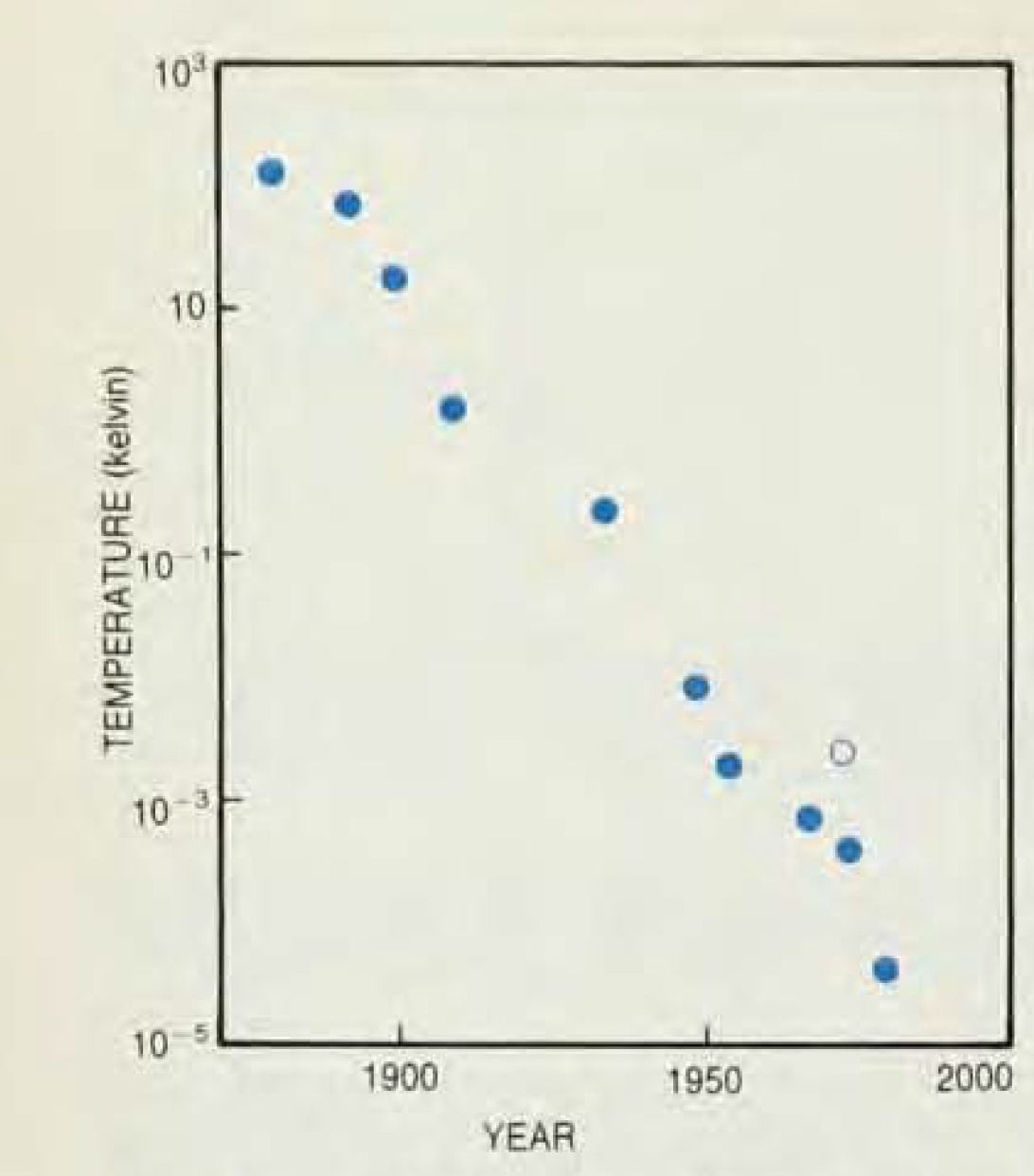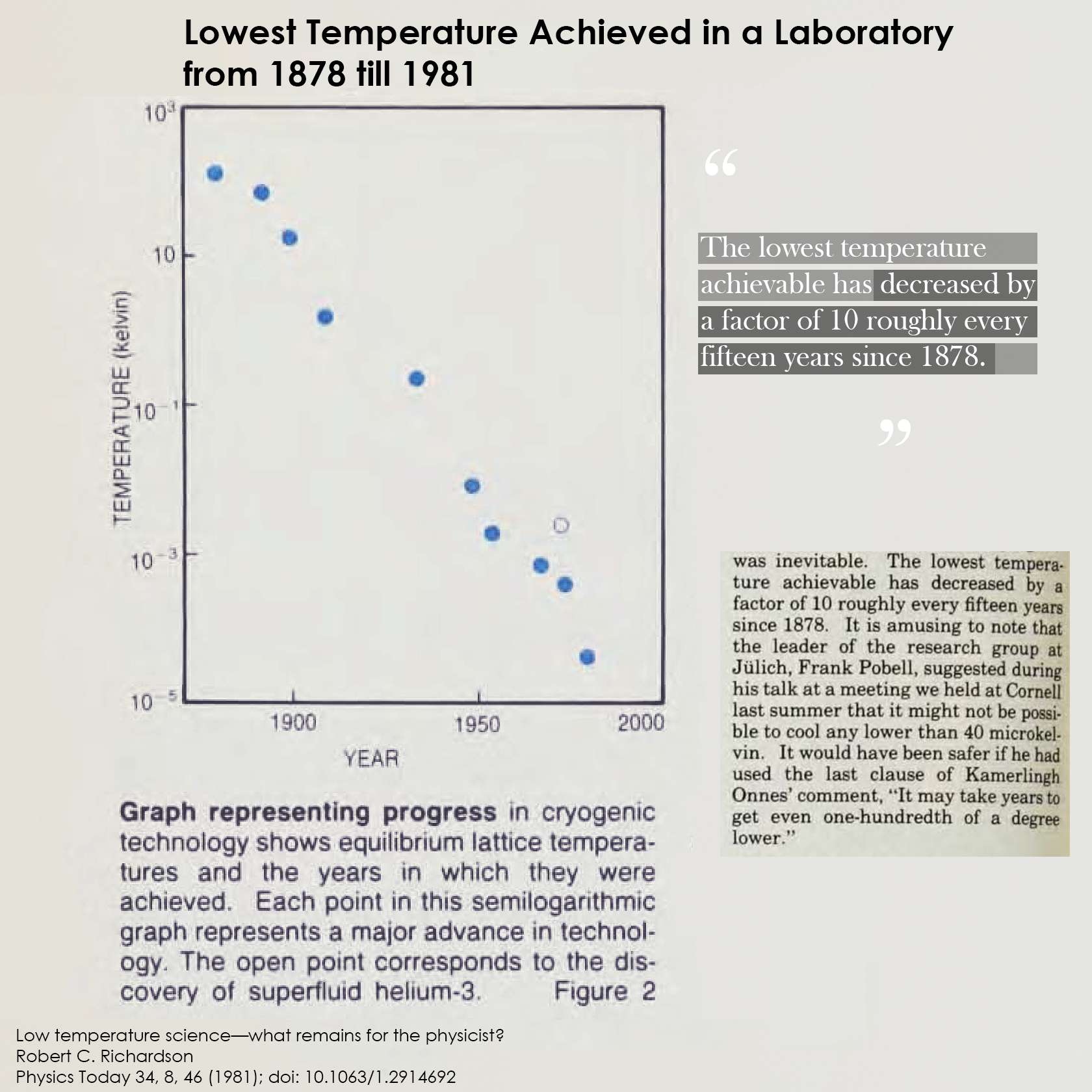About a month ago, I was searching for a hook to the talk I was supposed to give to the Alberta Section of the American Association Physics Teachers. The 10-minute talk had to be about my research, but unfortunately superfluid Helium-3 - and really condensed matter physics as a whole - requires a whole lot of motivation before we can get into the nitty gritty. In doing some general reading about superfluid Helium, I came across the above Physics Today article written by Bob Richardson.
Along with David Lee and Doug Osheroff, Bob Richardson discovered the superfluid nature of Helium-3 in 1972. This superfluid transition only happens below about 2.5 milliKelvins, which was just within reach of cryogenic technology back then. This was done using the combination of dilution refrigerator technology and the Pomeranchuk effect (see this book chapter). However, a different technique - nuclear demagnetization - had started surpassing the cooling rate achievable using these effects. To illustrate this, Figure 2 of his article shows the lowest-temperatures achieved over time, with the lone open circle in the plot being the discovery of superfluid Helium-3. This remarkable graph shows that progress in cryogenic technology has progressed at steady rate; The lowest temperature
achievable has decreased by a factor of 10 roughly every fifteen years since 1878.
The Mysteries of Figure 2
Though compelling, the text of the article was missing a lot of information about the individual data points. The first 5 points are related to the cooling down of common elemental gases; the 6th represents the nuclear demagnetization of Gd2(SO4)3.8H20; the open circle represents the discovery of superfluid Helium-3. The rest is frustratingly hard to pin down - how does one define a significant advance in cryogenic technology? Google has not been very forthcoming on this matter.

The other immediate question is, has this trend continued till today? After combing the internet, I came to the conclusion that there was no updated plot showing how this trend has fared over the last 40 years. I guess if you want a job done, you gotta do it yourself. *rolls up sleeves*
Taking up the gauntlet
After using WebPlotDigitizer to scrape the pre-1981 information from the Figure, I was able to start piecing together the details. A couple of usual suspects were responsible for the early data points (Kamerlingh Onnes, James Dewar) but the first was from a group I had not heard of (Louis Paul Cailletet from France and Raoul Pictet from Switzerland, plus Zygmunt Wróblewski and Karol Olszewski from Poland who may have been shafted the honours). I was able to figure out a couple of the data points in the middle, but the rest were maddeningly difficult to identify.
From 1981 onwards, I had a heck of a time figuring out which claims should make it onto this illustrious (and incomplete) list. The results from the Bose-Einstein Condensate (BEC) community starting in 1995 were the most obvious inclusions. However the Low Temperature Laboratory at Aalto University has a couple of claims using Rhodium which seem to have achieved a lower temperature earlier? I unfortunately do not have the experimental training to discern if this record is slightly different as it seems to only to the temperature of the nuclear spins. Hopefully someone can help me out here, but notwithstanding, it seemed to me that the data points on this updated list could be broadly classified into 5 groups:
- Cooling of gases (either liquefaction or solidification),
- Nuclear demagnetization,
- Unknown,
- Superfluid Helium-3 (included here because I play favourites) and,
- BEC.
The updated "Moore's Law" for Low Temperatures
After many hours of learning how to use Plotly , I present to you, a first-crack at updating the graph for cryogenic records. If you can help fill in any of the 'unknown' information or you have a strong opinion on further experiments which should be included in this plot, PLEASE PLEASE let me know! I would be more than happy to keep updating this figure. But let's discuss the main takeaway below first.
The trend continues!
Over the last 40 years, cryogenic advances have not continued falling by a factor of ten every 15 years - it has accelerated! In doing some research for this post, I came across the below prediction from a chapter in a review article from 1988: Assuming that the trend continues this suggests that 1 nK should be reached by about the year 2030.
Depending in which experiments you subscribe to, this milestone was passed only a few years after the publishing of this article, in the 1990s.

Microkelvin Physicsby G. R. Pickett, printed in 1988. The Figure 25 referenced in the text is very similar to the figure in Bob Richardson's article.
Which milestone is next?
Given the breakneck pace of cryogenic advances, and the history of under-predictions, it seems foolish to speculate what will come next. So I won't. ;) But it is a terrifyingly exciting time to be in condensed matter physics right now, and this is just one of the many reason it is so.
